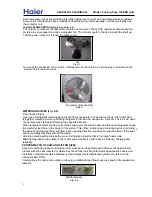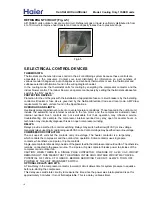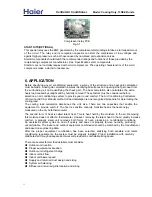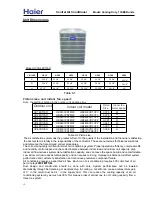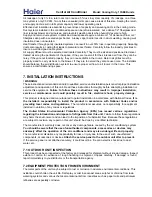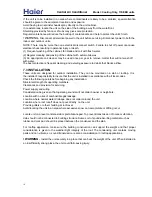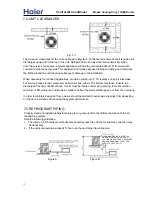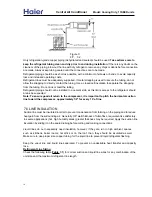
9
. SERVICE AND TROUBLESHOOTING
22
NEVER USE A WEATHER COVER OVER THE OUTDOOR UNIT
. The unit is designed to operate
outdoors. A cover traps moisture in the unit causing rust and corrosion .There is the added danger of
starting the system with the cover on. This prevent air flow through the outdoor coil causing dangerous
system pressure .Compressor damage
may
result.
WARNING
˖
THE ABILITY TO PROPERLY PERFORM SERVICE ON THIS EQUIPMENT REQUIRES
EXPERIENCE
ˈ
MECHANICAL SKILLS
,
TOOLS AND TEST EQUIPMENT .IF YOU
ARE
NOT
QUALIFIED,
DO NOT ATTEMPT TO PERFORM ANY
SERVICE
ON THIS EQUIPMENT
, CONSULT THE USER'S
MANUAL
FOR ROOTING MAINTENANCE THAT CAN BE DONE BY THE HOME OWNER
.
FAILURE TO FOLLOW THIS WARNING COULD RESULT IN POSSIBLE DAMAGE TO THE
EQUIPMENT, SERIOUS PERSONAL INJURY, OR DEATH.
The HVAC industry
, had improved the
efficiency
of the products offered to consumers. New and
more
sophisticated mechanical
and electronic features
for achieving higher efficiencies have been
design
ed. The use of test equipment is now more critical than ever.
In the servicing and troubleshooting section is information on compressors and other components and
their test procedures. There are troubleshooting charts, charging charts, wiring diagrams and service
guide
charts. Included is list of suggested test equipment.
T
his information
can be uesed by the service technician
to understand the installation
and troubleshooting
and operation of the
current familie of air conditioning. The procedures in this section are generic in content.
Each product family incorporates some of these components. Be aware of this is a guide compiled from
numerous sources. It can not take into consideration all conditions found in all installations.
Note:
Upon arrival at the job site,
a sound first step is a review of the system installation to identify any
obvioss problems, this
Installation Manual should be used as a guide.
REFRIGERANT RECOVERY
Refrigerant systems using chlorofluorocarbon (CFC) and Hydrochlorofluorocarbon (HCFC) refrigerants
system are subject regulation by
the clean air Act of 1990.
This act prohibits the
unrestricted release
Recovery
means to
collect the refrigerant in a
special holding container.
Recycling
means to run the
refrigerant through
a filtering system to remove most particles and moisture.
Reclaiming
means to
chemically reprocess t
he refrigerant to return it to its original purity.
Recovering and recycling
refrigerant is possible with the aid of mechanical devices made for the
purpose .The recovery system is a compressor
/
pump assembly, which removes refrigerant from
a
system and safely stores it in a
D
epartment of Transportation (DOT) approved container until it is
re-used or returned for reclaim.
refrigerant may happen in the course of normal service.
When performing service on a refrigerant system, charging should be done using the best service
of refrigerant into the air. Proper charging of refrigerant system may require
removing some
refrigerant when the system is overcharged. and is to be used by personnel with
appropriate industry
experience recover the excess refrigerant.
Always use procedures so as not to release any refrigeran.
practices, ensuing that the least amount of refrigerant needed is used.
Lines must be evacuated before charging with refrigerant.
TEST EQUIPMENT
The following test equipment is recommended to properly service air conditioning equipment:
RECYCLINE DEVICE WHEN DOING REFRIGERANT SERVICE.
1. A good quality volt/ohm meter;
3. A Magnetic Gauge (capable of reading to 3” W.C.)
5. A clamp-on ammeter.
2. A two-channel temperature electronic thermometer;
4. A refrigerant pressure Gauge manifold set;
The authors of the EPA regulations enforcing the Clean Air Act realized that an accidental release of the
WARNING : IN ORDER TO COMPLAY WITH FEDERAL LAW, ALWAYS USE A RECOVERY /
Central Air Conditioner
Model: Cooling Only,
13
SEER
units


